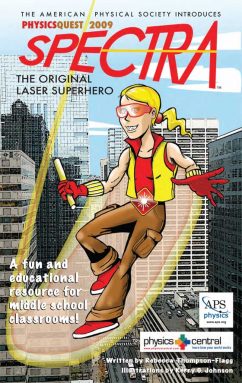Comic book heroine teaches science
A superhero with laser powers helps make physics fun
Many comic books have characters that challenge everything we know about physics and biology. A man who heals from bullet wounds in seconds. A hero brought to his knees in the presence of a mysterious element. A heroine who carries a lasso that forces someone to tell the truth. While it can be fun to imagine how such abilities could exist, most comic book heroes defy science; they don’t teach it. The American Physical Society is trying to change that with Spectra.

Spectra’s adventures also illustrate important physics lessons. Each comic book provides science projects that go along with the story. Melting Hershey Kisses suggests how different metals conduct heat. Stirring ketchup into water shows what different viscosities —or the “thicknesses” of fluids — look like. Numbers and other data from each experiment provide the information that Spectra and her friends can use to save the world from the villain of the week.
The concepts might be confusing, however, without the aid of a lesson plan. Spectra saves the world with her laser powers. But the comic book never fully explains what a laser is, how diffraction works or why different wavelengths of light appear as different colors. The comic also refers to products that use lasers. Yet it never actually shows how these products (such as iPods) make use of that technology. Having a teacher around to provide definitions and details will help readers glean the most from Spectra’s tales and the recommended experiments.
The American Physical Society developed the series, and produced the first issue in 2009. There are now five issues to choose from. Spectra’s tales are free on its website. Teachers can also download a special (and free) edition. It provides directions for projects and classroom activities. Teachers who register with the site also can get a free classroom kit. It has additional materials to support the Spectra series. Classes that complete the activities can enter their answers online for a chance to win prizes.
Follow Eureka! Lab on Twitter
Power Words
conductive Able to carry an electric current.
conductor (in physics and engineering) A material through which an electrical current can flow.
diffraction The bending of waves when they hit an object. The pattern produced by waves when they bend can be used to determine the structure of very tiny objects, such as the width of a human hair.
laser A device that generates an intense beam of coherent light of a single color. Lasers are used in drilling and cutting, alignment and guidance, and in surgery.
physics The scientific study of the nature and properties of matter and energy. Classical physicsAn explanation of the nature and properties of matter and energy that relies on descriptions such as Newton’s laws of motion. It’s an alternative to quantum physics in explaining the motions and behavior of matter.
viscosity The measure of a fluid’s resistance to stress. Viscosity corresponds to the idea of how “thick” a liquid is. Honey is very viscous, for instance, while water has relatively low viscosity.
wavelength The distance between one peak and the next in a series of waves, or the distance between one trough and the next. Visible light — which, like all electromagnetic radiation, travels in waves — includes wavelengths between about 380 nanometers (violet) and about 740 nanometers (red). Radiation with wavelengths shorter than visible light includes gamma rays, X-rays and ultraviolet light. Longer-wavelength radiation includes infrared light, microwaves and radio waves.







